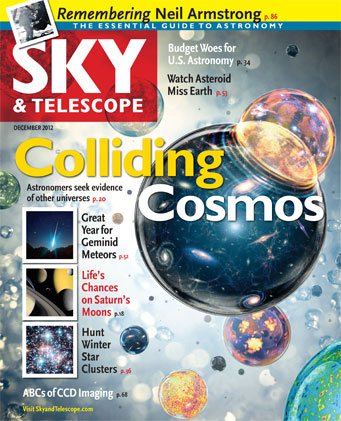Sky & Telescope's December 2012 issue is now available to digital subscribers. Some print subscribers may have already received it, and it's officially on-sale at newsstands starting November 6th.
| Update: A number of subscribers experienced difficulties accessing the December digital issue. The problem has since been resolved, so all digital subscribers should now be able to access the December issue. We apologize for any inconvenience. If you're still experiencing difficulties, don't hesitate to let us know at [email protected]. |

December 2012 S&T
December's cover story by S&T's Camille Carlisle turns my skepticism on its head. It turns out the multiverse may be a testable idea after all if our cosmos experienced a long-ago collision with one of its neighbors. The jury's still out if such cosmic bruises can be seen, but with the newest observations from Planck satellite, this realm of cosmology has a chance of moving from abstract math to testable theory.
Also in this issue, David A. Rodger delves into the lesser known star clusters that dot the night sky. Markarian, Stock, Trumpler, and Collinder are but a few of many open-cluster catalogs that have been compiled over the years. Those objects omitted from large, general catalogs (such as the NGC or IC) are not too faint to see — rather, they're better suited small, wide-field scopes or even binoculars. If you're looking for a new challenge without upgrading to heavy-duty optics, these catalogs are well worth checking out.
In our Observing section, explore Cassiopeia clusters with Sue French or observe lunar history &mdash testing your skills against famous astronomers of the 19th century — with Charles A. Wood.
And don't miss out on the eye candy as night falls: Jupiter shines bright all night long in December, rising around sunset on December 2nd, and find Uranus and Neptune around nightfall with our finder charts. And above all, don't miss the Geminid meteors, which should peak the night of December 13-14.
A guide to CCD imaging, the latest news on NSF budget woes, and reviews of the newest products all await you in our December issue.
To find out more, read our online Table of Contents.
 0
0
Comments
You must be logged in to post a comment.